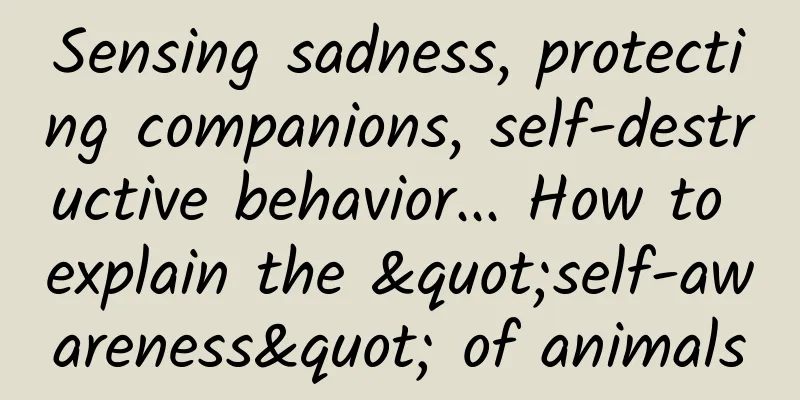Sensing sadness, protecting companions, self-destructive behavior... How to explain the "self-awareness" of animals

|
© The Dodo Leviathan Press: Wikipedia defines suicide as "active behavior that intends to cause the death of one's own body." This means that when we observe whether animals have suicidal behavior, we must take "self-awareness" into consideration: animals with self-awareness can not only perceive pain and sadness, but also understand what death means to them. Although we see many behavioral manifestations that are very similar to humans, such as cattle and sheep waiting to be slaughtered shedding tears, and elephants and dolphins surrounding their dead companions for a long time, we cannot be sure to what extent these animals have the same attitude towards death as we do. This reminds me of the rumor that lemmings committed suicide in groups. Unfortunately, this phenomenon, which was later named the Lemmings Effect, cannot prove that it is suicidal behavior. (www.smithsonianmag.com/smart-news/lemmings-do-not-explode-or-throw-themselves-cliffs-180953475/) So, what about the self-injurious behaviors of animals? For example, excessive licking by cats and dogs, and some birds pluck out their feathers, these behaviors may be related to disease and environmental stress, but we still don't know the exact answer. In April 1970, Ric O'Barry visited the Miami Seaquarium to see Kathy, a dolphin he had captured from the wild and trained to star in the television show Flipper for three years. She was "retired" at the time, and O'Barry recalled that she looked depressed. Cathy lived alone in a concrete tank, but dolphins are highly social animals, and this was not a good thing for her. O'Barry said the former dolphin show star swam into his arms, then sank to the bottom of the tank and refused to surface. She drowned herself. Casey the Dolphin and Rick O'Barry. © IAI TV The story is a moving one, reflecting the tragic plight of dolphins and other highly intelligent animals in captivity, and it resonates with people. As O'Barry said, Casey's death spurred him to action, and he has been committed to protecting marine mammals ever since. He is best known for his 2009 documentary The Cove, which exposed the killing of about 2,000 dolphins a year by locals in Taiji, Japan. Is animal suicide real? Do animals really take their own lives? What is suicide? Suicide is a complex issue, and we do not fully understand why humans commit suicide. The causes of human suicide are still unclear, and in the Diagnostic and Statistical Manual of Mental Disorders (Fifth Edition) (DSM-5) published by the American Psychiatric Association (APA), suicidal behavior disorder is listed as a "disorder requiring further study." Even the factors that determine human suicide are worth discussing - this is a question of biology and psychology, as well as philosophy and semantics. (www.ncbi.nlm.nih.gov/pmc/articles/PMC7891495/) For example, do kamikaze pilots and "suicide bombers" really commit suicide? Generally speaking, they do not show the psychopathological characteristics of suicide, and their motivations are more political or religious than a true death wish. Is suicide an active choice or the result of a pathological state? This is crucial if we are to study suicide in animals, because animals have different choices than humans, who have the unique ability to comprehensively analyze the past, present and future, while animals do not. (www.ncbi.nlm.nih.gov/pmc/articles/PMC4267802/) © Amnesty PLUS The association of suicide with severe mental illness (SMI), the hypothesis that suicidal tendencies may be hereditary, and the controversial suggestion that antidepressant medications may increase suicide risk in young people all suggest that suicide may not be a choice in some cases—if we consider choices to be rational decisions made in a stable psychological state. If so, should people who choose to end their lives in the face of terminal illness—arguably a rational choice—be called "suicide"? How should suicide be defined? (www.ncbi.nlm.nih.gov/pmc/articles/PMC6918821/) (www.ncbi.nlm.nih.gov/books/NBK107191/) (www.frontiersin.org/articles/10.3389/fpsyt.2019.00294/full) A stranded whale in Flinders Bay, Australia. © The Conversation While we are learning more and more about animal consciousness, is there enough evidence to suggest that some animals can not only feel pain, but also recognize the concept of death and plan their own deaths? To be sure, we do know that animals have varying degrees of self-awareness, experience depression, anxiety and other mental illnesses, are capable of self-destruction, have some concept of death, at least express grief when a fellow animal dies, and in some cases are able to plan for the future. (www.researchgate.net/publication/265114159_Self-awareness_in_animals) (link.springer.com/content/pdf/10.1007/s10670-019-00187-2.pdf) Animal Alienism Still, critics say the idea that animals are capable of suicide is a form of anthropomorphism - attributing human traits to non-human beings. Just because a dolphin looks depressed and doesn't surface for air doesn't mean it's killing itself. CA Soper, a skeptic and author of The Evolution of Suicide, argues that cases like Kesey's death "say more about the observer than the observed." (www.frontiersin.org/articles/10.3389/fpsyg.2018.02136/full) Those who support the possibility of animal suicide—most of whom are quick to say they’re not entirely sure—call the above claims “anthropo-denial.” In other words, they think it’s too hasty to dismiss the possibility that animals think and act in uniquely human ways based on preliminary observations. Instead, they insist that we should look at the extent of these abilities. Just because animals may express sadness, depression, happiness, or anger differently than humans do, that doesn’t mean the ability to express emotions doesn’t exist. The same, they insist, is true of suicidal behavior. “We need to learn to accept this — to be cautious about either approach and adopt what I call ‘epistemic humility,’ ” said David Peña-Guzman, a philosophy professor at San Francisco State University. In 2017, he published an article on the topic in the journal Animal Sentience, which prompted a variety of responses from other experts in the field, some supporting and some opposing. Peña-Guzman wrote another article in 2018 to respond to critics. (www.wellbeingintlstudiesrepository.org/cgi/viewcontent.cgi?article=1201&context=animsent) “What was interesting was that the critics realized that they couldn’t actually agree with each other,” he recalls. Indeed, the issue is complex, and the positive evidence is mostly single observations and inferences, not empirical evidence. Interpretations vary widely. Chimpanzee Flint (left) with his mother Flo and Goodall. © Flickr Jane Goodall recalls the death of one of her subjects, the chimpanzee Flint. After his mother, Flo, died in Gombe National Park in Tanzania, Flint seemed to have lost the will to live and died a month later. Similar situations have occurred in dogs and elephants. These observations are striking, but do these cases fit the suicide semantics used to describe human death? Usually, we assume that suicide involves some intent, even if the victim is under extreme duress or mental instability. We can't prove that Flint starved himself intentionally - we don't know. Poco, a chimpanzee living at the Sweetwaters Chimpanzee Sanctuary in Kenya, spent nearly a decade in captivity before being rescued. His symptoms were considered to meet the criteria for post-traumatic stress disorder (PTSD). © ResearchGate “I think it’s a little bit like dark matter, where we don’t have enough observations to really explain why,” said Ryan Hediger, who studies animal experiments and teaches English at Kent State University and was one of the responders to Peña-Guzmán’s article. Some tiny ants, such as weaver ants, can explode and release a deadly yellow liquid to kill larger predators. © Alexey Kopchinskiy It’s worth noting that some of the self-destructive behaviors in the animal kingdom are almost certainly not suicide in any sense of the word. Ants and aphids protect their own kind by exploding when predators approach. Certain species of bees leave their nests after being parasitized by a parasitic fly to avoid endangering the colony. While research on invertebrate sentience suggests that insects can feel pain, among other things, these behaviors are almost instinctive rather than determined by individual choice. Similarly, lemmings jumping off cliffs to commit suicide are more likely to be the accidental result of excess population rather than a conscious leap into the abyss by individuals. (doi.org/10.3897/zookeys.751.22661) (www.wellbeingintlstudiesrepository.org/cgi/viewcontent.cgi?article=1527&context=animsent) Intentional or not Other examples are more difficult to explain. Famous field biologist George Schaller tells of an example in which a buffalo fled back to its herd after being mauled by a lion, but then, unbelievably, it somehow left the protection of the herd to allow the lion to feast on it. Did it deliberately allow the predator to take its own life, knowing that its wounds were irreparable? Or was it motivated by some other motive, such as insanity or a desire to divert the predator to protect its herd? An Asiatic black bear rescued from an illegal bear bile factory. © Hoang Dinh Nam Another example mentioned in the text involving animal suicide is equally subjective in its interpretation. In her 2013 book How Animals Grieve, Barbara King tells the story of a mother bear and her cub being squeezed for bile. The practice of extracting bear bile, which is mainly practiced in Asian countries and is believed to have medicinal properties, involves inserting a catheter into the bear's body, a particularly cruel process. The mother bear supposedly broke free, suffocated her cub, and then ended her life by ramming her head against a wall. It seems incredible that the animal would deliberately kill its cub and then itself in order to escape a tragic fate. A more likely explanation is that the mother bear panicked or was driven mad by the cruel torture. The above examples illustrate the main challenges in assessing the potential for suicide in animals. For an animal to be suicidal, it must be self-aware, understand what death actually means, and be able to perform a series of behaviors that it knows will lead to its own death. There are some signs of the first two abilities, but the last is harder to discern. Dolphins and some primates mourn their dead, but this is not enough to prove that they actually understand and can facilitate their own death. (www.smithsonianmag.com/smart-news/study-suggests-dolphins-and-some-whales-grieve-their-dead-180969414/) A striped dolphin appears to mourn the loss of one of its own in the Gulf of Corinth. © Silvia Bonizzoni/Dolphin Biology and Conservation Even assuming that O’Barry, Goodall and others are correct that their subjects knew they were ending their lives, there is still a definitional problem - although actions like stopping eating or breathing can be considered self-destructive, can they really be considered suicide? Peña-Guzmán believes that this can be considered suicide in some sense. "There is a question in the human psychology literature: Is suicide limited to active self-destruction, or does it also include passive suicide? I prefer a broader definition that can explain cases like Flint's." Soper counters: "A lot of the confusion about animal suicide stems from invalid definitions. Those who think non-humans can or might commit suicide are basing their definition of suicide on a very broad definition that any arguably self-injurious behavior can qualify as suicide." John Hadley, an expert in animal and environmental ethics at Western Sydney University, added: “The definition of suicide is relatively uncontroversial, as the deliberate act of ending one’s life after some reflective judgement that it is not worth living any longer. When considering whether animals commit suicide, if we define it in this straightforward way, as a descriptive or scientific fact based on the available evidence, I think we have to say no.” Others who question the possibility of animal suicide point out that suicide is rare in pre-teens and children with developmental disabilities. Even the smartest animals have no more than the intelligence of a teenager. This raises the question of whether animals are capable of deliberately conceiving of suicide - let alone carrying it out. (www.proquest.com/openview/b3c5f1b1e99aee4d4a0020e49743e8ba/1?pq-origsite=gscholar&cbl=18750&diss=y) (cdn.doctorsonly.co.il/2011/12/2006_4_5.pdf) “If this idea is incomprehensible to toddlers, it’s probably not incomprehensible to less intelligent animals either,” Soper said. We can imagine that whether animals commit suicide can be verified through experiments. But this practice is unethical. Deliberately forcing an animal to a state where it may seek death touches the bottom line of animal experiments. Of course, this does not mean that people will not try to do so. (www.wellbeingintlstudiesrepository.org/cgi/viewcontent.cgi?article=1286&context=animsent) In the meantime, we are left to ponder a series of largely unanswerable questions. Is it easier to simply acknowledge or deny the possibility of animal suicide? This question is almost impossible to answer. But given the astonishing discoveries in the field of animal consciousness in recent decades, further insights are sure to emerge. By Richard Pallardy Translated by Rachel Proofreading/Yord Original article/www.discovermagazine.com/planet-earth/do-animals-commit-suicide This article is based on the Creative Commons License (BY-NC) and is published by Rachel on Leviathan The article only reflects the author's views and does not necessarily represent the position of Leviathan |
>>: Summer study, please check out these tips for eye protection
Recommend
Not the Onion, but bumblebees are really becoming a fish in California!
Starting from May 31 this year, four species of b...
Is the birthday greeting video of an African child real? A group of African children shouting birthday wishes
A simple small blackboard with words written on i...
New media operation: How to build a self-media matrix?
Many students would say: It’s 2020, can self-medi...
The 5-year-old iPad is at a crossroads. Where should it go?
On April 7, Apple has launched the classic tablet...
The national temperature record low progress chart has been released. Which day will be the coldest in your area?
From the 24th to the 27th, the central and easter...
Why are older people more vulnerable to online rumors?
Nowadays, we play with our phones every day, and ...
Meritorious Person丨Sun Jiadong——the "Father of Satellites" who creates stars and fills the sky
April 8th is Academician Sun Jiadong’s birthday T...
Are those extremely low-level information flow ads really effective?
The online game advertisement mentioned by the to...
Understand brand communication in 3 sentences!
This article starts with the topic of communicati...
A new addition to the high-temperature superconductor family! Why do we keep searching for high-temperature superconductors?
The discovery of high-temperature superconductivi...
7 essential skills for operators: Data analysis ability is the watershed of future operations
The era of traffic-centric, barbaric operations h...
3 strategies for native advertising!
Only by using fewer "tricks" can you tr...
How to screen for the 9 most common cancers? The more expensive, the better!
Source: Youlai Healthy Life...
How do these nearsighted shooting champions hit the bull's eye?
Column design: 91 Author of this issue: Guo Yiche...
Do hair dyes cause cancer? After testing 16 popular hair dyes, we finally figured it out.
For a long time, hair dye and cancer have been fi...









